White velvet cake is as soft and silky as its name suggests
Red velvet's cousin is a versatile, reliable recipe for every occasion.
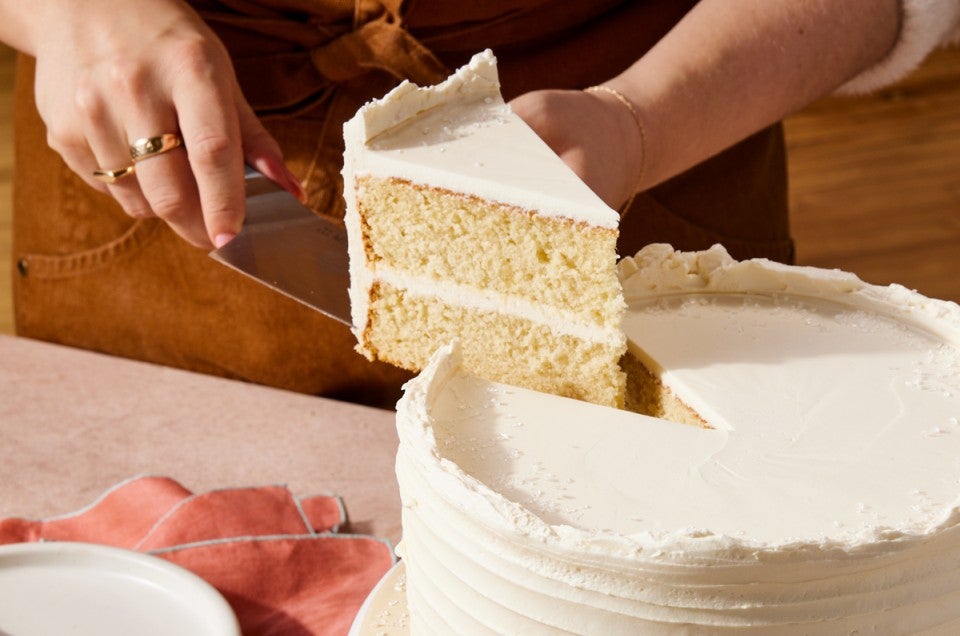

You’ve probably heard of red velvet cake, the classic Southern dessert vividly tinted with red food coloring and a hint of cocoa powder. But what about white velvet cake, its lesser-known counterpart?
A cousin of red velvet, it couldn’t look more different, but the cakes themselves are similar. As their names imply, both styles of cake are distinguished by their plush, tender, velvety crumb. And both white and red velvet cakes also include buttermilk, which contributes to their signature tang while also helping with leavening and overall texture. The primary differences are in their color and flavor: The omission of food coloring and cocoa powder in white velvet cake sets it apart from its brighter, more chocolate-flavored counterpart.
It’s often hard to say exactly when a specific style of cake came into existence, but most historians believe that velvet cakes date back to the post-Civil War Reconstruction era, when white velvet cake was popularized by a number of magazines in the late 1860s and 1870s. During the late Victorian era, velvet cakes were aptly named for their velvety, delicate texture, compared to the coarser-crumbed cakes that came before them. In fact, it’s very possible that white velvet cake preceded its more popular red counterpart. According to baker and cookbook author Stella Parks, devil’s food cake, a rich chocolate cake, also existed during this time, and sometime in the early 20th century, the two cake styles likely merged to create the first iterations of what we now refer to as red velvet cake: a velvet-style cake made with cocoa powder for a subtle chocolate flavor and classic reddish hue.
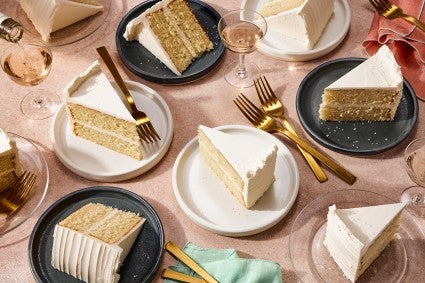
Somewhere along the way, red velvet cake emerged as the dominating style, and white velvet cakes faded mostly into obscurity. But though lesser known today, white velvet cake offers more versatility than red velvet and is the ideal tender buttermilk-based cake for any occasion. At first glance, this white velvet cake may seem like any other white cake recipe, but this particular cake owes its soft and satiny texture to a few key ingredients and steps.
Buttermilk: As mentioned earlier, buttermilk is the signature ingredient that gives white velvet cake its distinctive light, melt-in-your-mouth texture. Buttermilk is a cultured dairy product, much thicker and more acidic than milk. Buttermilk’s high acidity works in baked goods to break down gluten strands and protein structures that begin to develop when the flour is mixed with liquid, resulting in a more tender mouthfeel. Buttermilk also contributes to leavening — the acidic buttermilk activates the baking soda, and this reaction produces carbon dioxide, which gives the cake more lift and lightness.
Cornstarch: There’s also cornstarch, which acts as a tenderizer here. The addition of 1/4 cup (28g) of cornstarch reduces the gluten content in the recipe, resulting in a softer, fluffier cake. Basically, the combination of all-purpose flour plus cornstarch acts as a substitute for cake flour, lowering the protein content and leading to more tender layers.
Egg whites: Though most red velvet cake recipes use whole eggs, this white velvet recipe relies on egg whites only. Using just whites instead of whole eggs gives the cake a creamy white color to match its name.
Butter + oil: The combination of butter and oil in this recipe gives you the best of both worlds: Butter lends rich flavor, while oil ensures a moist texture.
Flavorings: In this recipe, the trifecta of vanilla extract, almond extract, and lemon juice powder gives white velvet cake that signature nostalgic bakery flavor. Lean into this old-fashioned sensibility and choose a classic frosting to accompany: Cream cheese or ermine frosting both pair beautifully with this cake.
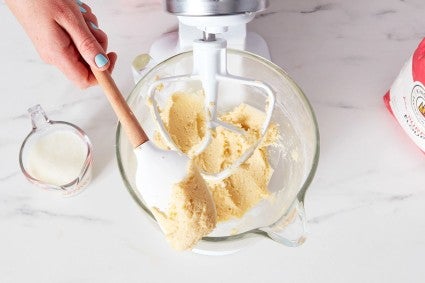
Lastly, this recipe relies on the reverse creaming method, which results in a tight, soft crumb. After the dry ingredients are mixed together, the room-temperature butter is beaten into the dry mixture, limiting gluten formation. Once the mixture looks like coarse sand, the liquid ingredients gradually get poured in, yielding a smooth batter that bakes into a delicate cake. The resulting cake also has less doming and a sturdy texture, making it ideal for stacking and layering.
It may just be that red velvet cake has been in the spotlight for too long. Now, it’s white velvet cake’s time to shine.
Cover photo by Rick Holbrook; food styling by Kaitlin Wayne.
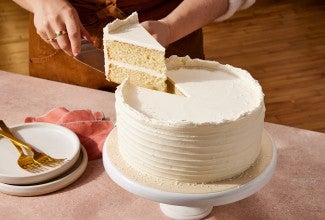
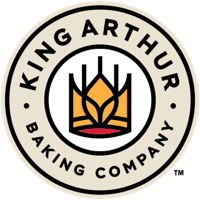

March 17, 2024 at 5:49pm
I admit to being confused about cornstarch while using GF Measure for Measure flour. If cornstarch is added to a regular flour to reduce gluten, why would we need to add it to a GF flour at all? If cornstarch provides another benefit, what ratio of cornstarch to Measure for Measure do you recommend? My last 2 cakes using M-f-M and cornstarch (in attempt to make a GF cake flour) have been much too dense and I wonder if the cornstarch is causing this? Thanks for your help!
March 18, 2024 at 10:53am
In reply to I admit to being confused… by Kathy (not verified)
Hi Kathy, you make an excellent point when it comes to substituting our Gluten-Free Measure for Measure Flour into this recipe. Since reducing the gluten content isn't really an issue, we would advise leaving out the cornstarch in this recipe when using this type of gluten-free flour in place of the Unbleached All-Purpose Flour. As always, we recommend either weighing your flour (our M4M weights the same as our AP flour) or using this method to measure your flour by cups, which will help ensure that you don't add extra flour to the recipe.
February 25, 2024 at 10:42am
What would change besides the color if you used the whole egg?
March 2, 2024 at 11:19am
In reply to What would change besides… by Martha (not verified)
Hi Martha, since this recipe calls for 5 egg whites, it would make quite a bit of difference to the recipe if you added 5 yolks as well. The liquid/dry balance of ingredients would be thrown off, which would affect texture and baking time, and the cake might be more likely to fall. If you don’t want to separate 5 large eggs and be left with the yolks, you could consider substituting packaged refrigerated egg whites, found near the eggs in your supermarket’s dairy section.
February 23, 2024 at 4:30pm
The cake looks great baking in the oven but it is taking 20 min. And counting more time than the two layer version. Please be aware.
February 22, 2024 at 9:19am
I love that you have developed a recipe that can duplicate cake flour- even avid bakers may not have it in their pantries. Because I received a gift of White Lily Flour for Christmas I am in a bake a pretty cake phase, lol. I am wondering if this flour might be a good substitute.
February 26, 2024 at 3:49pm
In reply to I love that you have… by Elizabeth Bell… (not verified)
Hi Elizabeth! You can certainly use White Lily for cake baking. It would be akin to using a cake flour as it is milled from a soft winter heat. Happy baking!
February 14, 2024 at 2:22pm
What frosting do you recommend for this cake?
February 20, 2024 at 2:04pm
In reply to What frosting do you… by David Schildkret (not verified)
Hi David, step 9 of the recipe links our recommended frosting recipes!
February 20, 2024 at 10:22pm
In reply to What frosting do you… by David Schildkret (not verified)
What frosting do you recommend for the White Velvet Cake?
Pagination